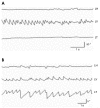Upbeat nystagmus: clinicoanatomical correlations in 15 patients
- PMID: 20396486
- PMCID: PMC2854944
- DOI: 10.3988/jcn.2006.2.1.58
Upbeat nystagmus: clinicoanatomical correlations in 15 patients
Abstract
Background and purpose: The mechanism of upbeat nystagmus is unknown and clinicoanatomical correlative studies in series of patients with upbeat nystagmus are limited.
Methods: Fifteen patients with upbeat nystagmus received full neuro-ophthalmological evaluation by the senior author. Nystagmus was observed using video Frenzel goggles and recorded with video-oculography. Brain lesions were documented with MRI.
Results: LESIONS RESPONSIBLE FOR NYSTAGMUS WERE FOUND THROUGHOUT THE BRAINSTEM, MAINLY IN THE PARAMEDIAN AREA: in the medulla (n=8), pons (n=3), pons and midbrain with or without cerebellar lesions (n=3), and midbrain and thalamus (n=1). Underlying diseases comprised cerebral infarction (n=10), multiple sclerosis (n=2), cerebral hemorrhage (n=1), Wernicke encephalopathy (n=1), and hydrocephalus (n=1). Upbeat nystagmus was mostly transient and showed occasional evolution during the acute phase. In one patient with a bilateral medial medullary infarction, the upbeat nystagmus changed into a hemiseesaw pattern with near complete resolution of the unilateral lesion. Gaze and positional changes usually affected both the intensity and direction of the nystagmus. A patient with a cervicomedullary lesion showed a reversal of upbeat into downbeat nystagmus by straight-head hanging and leftward head turning while in the supine position. Gaze-evoked nystagmus (n=7), ocular tilt reaction (n=7), and internuclear ophthalmoplegia (n=4) were also commonly associated with upbeat nystagmus.
Conclusions: In view of the responsible lesions and associated neuro-ophthalmological findings, upbeat nystagmus may be ascribed to damage to the pathways mediating the upward vestibulo-ocular reflex or the neural integrators involved in vertical gaze holding.
Keywords: Neural integrator; Upbeat nystagmus; Vestibulo-ocular reflex.
Figures



References
-
- Leigh RJ, Zee DS. The neurology of eye movements. 3rd edn. New York: Oxford University Press; 1999.
-
- Kumar A, Patni AH, Charbel F. The Chiari I malformation and the neurotologist. Otol Neurotol. 2002;23:727–735. - PubMed
-
- Zingler VC, Strupp M, Jahn K, Glaser M, Herberger S, Kretzschmar HA, et al. Upbeat nystagmus as the initial clinical sign of Creutzfeldt-Jakob disease. Ann Neurol. 2005;57:607–608. - PubMed
-
- Jay WM, Marcus RW, Jay MS. Primary position upbeat nystagmus with organophosphate poisoning. J Pediatr Ophthalmol Strabismus. 1982;19:318–319. - PubMed
-
- Sibony PA, Evinger C, Manning KA. Tobacco-induced primary-position upbeat nystagmus. Ann Neurol. 1987;21:53–58. - PubMed
LinkOut - more resources
Full Text Sources

